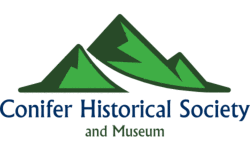Nestled in the foothills of the Rocky Mountains at 8,277 feet, Conifer is an unincorporated community in Jefferson County located 33 miles southwest of Denver, Colorado. It encompasses areas of Morrison to the east and Pine to the southwest. The highest point is Black Mountain at 10,756 feet, while the lowest is along the banks of South Turkey Creek in Morrison at ~6800 feet.
Conifer has been home to wildlife and Ancient Peoples for at least 12,000 years. The Ute Trail was frequently traveled by Utes, Arapaho, and Cheyenne tribes, traveling in groups of 20-25 people. They migrated seasonally, hunting large and small game, waterfowl, and fish with stone-chipped spears and foraging for mature vegetation at increasingly higher elevations as seasons progressed from spring to summer and fall. In the winter, they returned to their shelters along the Hogback and the Red Rock Formations at the base of the foothills. Stone circles, a tipi ring, and ancient artifacts discovered in site surveys along the old Ute Trail at the current-day Flying J Ranch Park tell us that the Conifer area has a long history predating modern settlement.
The Junction District was established on August 11, 1860 and included parts of what is now Conifer and Evergreen. It was one of the first established districts in the area, which was then part of Kansas Territory. Junction District predated the founding of both Jefferson County and Colorado Territory. The district’s main hub was an intersection where the Mount Vernon Toll Road and the Bradford Toll Road met. It was called Bradford Junction in those early years. The town sprouted as a community stage stop where travelers rested while traveling via wagon to the mining towns in and around Leadville.
Those who traveled the Bradford Toll Road paid at least $1 for the convenience and would stay at the hotel for a night before continuing their journeys. It was a crossroads, stage-stop, resort, community center, dance hall, commercial center, post office, and marketplace for timber, dairy, livestock, and many crops, including hay, lettuce, turnips, potatoes, and field peas. The town had many names, including Junction and Hutchinson.
While many people passed through, some came with plans to establish plots through the Homestead Act of 1860. The first homestead patent in the Conifer area was granted in 1873 to Silas P. Elliott. This homestead encompasses the present-day intersection of Highway 73 and Barkley Road, and the lower section of Shadow Mountain Drive. His brother, John C. Elliott, held the second homestead patent directly to the south. These were the first of many homesteaders to call the Conifer area home, but certainly not the last.
As the population grew, so did the need for infrastructure. Farmers and ranchers established modest homesteads using logs and stones native to the site. The first post office was established in May 1865, with postal service running a few times weekly to neighboring areas like Critchell, Marshdale, and Foxton, then to Morrison and Denver. Small one-room schoolhouses were built throughout the region, with the first being the Junction School in 1879, followed by the Hutchinson School in 1885. The surrounding towns ebbed and flowed as industries boomed and eventually busted. The area adopted the name of Conifer by the late 1890’s.
By the early 20th century, mining ventures in the area had ceased operations. Logging, fox farming, and hay harvesting thrived. As motor vehicles gained popularity, motor clubs adventured throughout the mountains and foothills, bringing more tourists into the mix. Small vacation communities like Red Wing Park and Shadow Mountain were built. By 1950, improvements to Highway 285 ensured that more people could travel to the area safely and in record time. More people moved to Conifer full-time by the mid-20th century, as they could easily commute to Denver and the suburbs.
As Conifer transformed from a farming and ranching community to a daily commuter one, the needs of the residents evolved. With the population growth came convenience, stores, banks, restaurants, and opportunities. Full-time residences were established, and larger schools were built to meet the growing community’s needs. Unfortunately, when the West Jefferson School opened in 1955, it quickly ran out of capacity. The community worked efficiently to repurpose old school buildings, using them as community centers, preschools, and libraries.
Large homestead properties were subdivided into communities of single-family homes, while others were deeded to Jefferson County Open Space and preserved as parks. A few homesteads continue to operate as working ranches or farms. The Jefferson County Planning Commission developed and adopted the first Conifer-285 Corridor Area Community Plan in 1987, revising it in 2003 and 2016; these served as guidelines for appropriate land use in the area. While still an unincorporated town, Conifer has grown from 408 residents in 1950 to over 9,000 today.
Thankfully many places still exist to show us what life was like for Conifer’s early settlers. Registered historic properties like the ones at Bradford Junction (the Yellow Barn, Ranch House, and Caretaker’s House), the Conifer Junction School / Little White Schoolhouse, and the Pleasant Park Grange have been preserved. Meyer Ranch and the iconic Midway House greet residents and visitors as they approach Conifer on southbound Highway 285. Pioneers and their families rest in the Conifer Kemp Cemetery and Pleasant Park Cemetery. Rightfully so, the area continues to welcome visitors who recreate in Conifer’s many Open Space parks, Staunton State Park, and the Pike National Forest.
Copyright Conifer Historical Society & Museum, 2023
